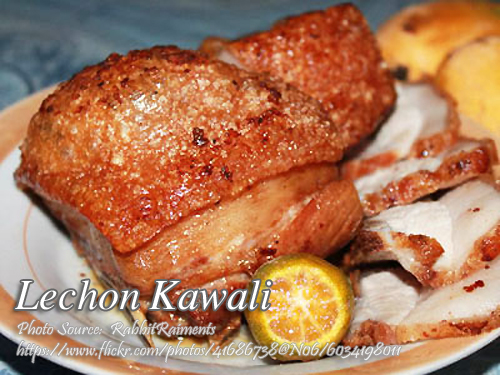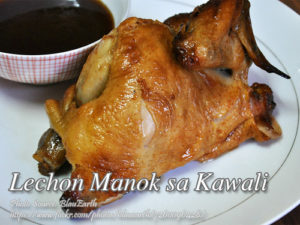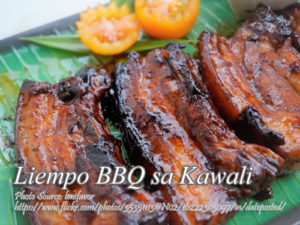One of the well known and favorite Filipino dish is lechon kawali. I’m not sure why it is called lechon in the first place because lechon dishes are usually roasted or broiled over live charcoals like the popular “Lechon” or roasted pig and the “lechon manok” or roasted chicken. Since this dish is a whole chunk of pork belly deep fried until the skin is crispy, I think this should be called fried pork belly or pritong liempo. Anyway this is the way it is traditionally called so we might just as well enjoy it!
Lechon Kawali with Liver Sauce: A Crispy Favorite from My Childhood
If there’s one dish that always takes me back to my childhood, it’s lechon kawali. I remember every Sunday, the smell of frying pork would fill the house, and my siblings and I would hover around the kitchen, waiting for that glorious moment when Mama would slice the golden, crunchy pork belly. My Uncle Tony used to joke that you’d know it’s ready when the skin starts “dancing” in the oil — that’s when the magic happens.
To this day, I can’t hear the sizzle of hot oil without thinking of those lazy Sunday lunches, when the table was full, the rice pot was steaming, and everyone fought for the piece with the crispiest skin.
Why It’s Called Lechon Kawali
Funny thing is, this dish isn’t really lechon in the traditional sense. In the Philippines, lechon usually means roasted over charcoal — like lechon baboy or lechon manok. But lechon kawali takes a different route. Instead of roasting, the pork belly is boiled, air-dried, and deep-fried until the skin turns shatteringly crisp. It’s basically pritong liempo, but the name stuck through generations.
Some say it was called lechon kawali because it mimics the roasted flavor and crispness of lechon, only it’s done in a kawali — the Filipino wok. Whether that story is true or not, one bite of that crunchy skin and juicy meat will make you forget all debates about the name.
The Secret to Perfectly Crispy Lechon Kawali
My Tita Nena, who’s known in our family as the “queen of the kawali,” swears that patience is the real secret. “Hindi puwedeng minamadali,” she always says — you can’t rush a perfect fry.
The first step is boiling the pork belly with salt and a bit of seasoning until the skin becomes soft enough to pinch easily. This step helps render some of the fat and tenderizes the meat inside. After boiling, it’s important to cool and air-dry the pork completely. My cousin Lito hangs the slab by the kitchen window, letting the breeze do the work. This drying process removes moisture, so when you deep-fry later, the skin turns crisp instead of soggy.
When you finally drop it into hot oil, stand back — the oil will hiss, bubble, and pop as the moisture trapped under the skin escapes. Those “tiny blasters” that appear on the surface? That’s your crispy skin being born. Frying in small batches also helps keep the temperature steady, so each piece fries evenly.
The Heart of the Dish: The Liver Sauce
No lechon kawali is complete without that rich, tangy liver sauce on the side. My Lola Merly always said the sauce is what ties everything together — the crispy pork, the soft rice, and that savory-sweet dip that balances the richness.
Her recipe is simple but spot-on. She mixes mashed liver, vinegar, water, breadcrumbs, sugar, and spices. The mixture simmers slowly until thick and fragrant. A bit of garlic sautéed in oil adds aroma, while the vinegar cuts through the fattiness of the pork. It’s a combination that never fails to make people reach for one more serving.
And here’s a tip I learned from my brother Jun: let the sauce rest before serving. The flavors mellow out and deepen as it cools, making it even more irresistible.
A Bit of History to Chew On
While lechon kawali feels like a modern comfort food, its roots go back to the Spanish colonial period. The word lechon itself comes from the Spanish leche, meaning milk, since lechon originally referred to suckling pigs. Over time, Filipinos gave it their own spin — roasting or frying larger cuts of pork belly and serving it with liver sauce, another Spanish influence that evolved into our well-loved sarsa.
Every Filipino household has its own version. Some add bay leaves or peppercorns to the boiling water for aroma, while others finish it in the oven for extra crispness. However you do it, the goal remains the same — that satisfying crunch followed by juicy, flavorful meat inside.
Sharing the Crispy Joy
These days, I cook lechon kawali for my own family, and every time I see my kids waiting by the kitchen door, I can’t help but smile. It’s like reliving my own childhood. The sound, the smell, the laughter — they all come rushing back with each crackle of pork skin.
There’s something special about dishes like this. They remind us that food isn’t just about eating — it’s about gathering, sharing, and keeping traditions alive. Whether you call it fried pork belly or lechon kawali, one thing’s for sure: once that crispy goodness hits the table, it’s gone in minutes.
So next time you’re craving something truly Filipino, bring out your kawali, heat that oil, and get ready to make your kitchen smell like home.
How to Cook Lechon Kawali with Liver Sauce
Ingredients
Lechon Kawali Ingredients:
- 1 kilo pork belly or liempo
- 4 cup water
- 2 tbsp. salt
- 1 tsp. MSG
Lechon liver Sauce Ingredients:
- 1 cup liver paste or liver spread
- 1 pc bay leaf or laurel
- 3/4 cup native vinegar
- salt and pepper to taste
- 1 & 1/2 cup water
- 1/4 tsp. MSG
- 1/3 cup bread crumbs
- 2 Tbsp. cooking oil or lard
- 1/2 cup sugar
- 1 head garlic minced
- 1 pack kasubha American saffron or safflower
- 6 pieces shallots sliced fine
Instructions
How to cook Lechon Kawali:
- Boil pork belly in water with salt and MSG until skin can be pinched easily.
- Remove from fire and drain Cool and air-dry.
- Deep-fry in a deep saucepan until tiny blasters appear on the skin.
- Chop into serving pieces and serve with Lechon-liver Sauce.
How to cook Lechon Kawali Sauce:
- Mix liver paste, vinegar, water, bread crumbs, sugar, 1/2 of the kasubha, laurel, salt, pepper and MSG.
- Blend well and set aside. Saute garlic in cooking oil.
- Add the onions and fry until tender. Add the liver mixture.
- Boil without stirring. Do not cover the saucepan.
- Add the rest of the bread crumbs dispersed in 1 cup of water. Cook till it thickens.
- Serve sauce topped with the rest of the crisp brown garlic and fried kasubha. Good for 6 persons.
Notes
Cooking Tips:
Dry the Pork Thoroughly Before Frying
After boiling, let the pork belly cool completely and air-dry for at least an hour. This step removes excess moisture that can cause oil to splatter and prevent the skin from crisping properly. The drier the pork, the crunchier the result once it hits the hot oil.Control the Oil Temperature
Maintain a consistent medium-high heat when frying your lechon kawali. If the oil is too hot, the skin burns before the meat crisps; too low, and the pork absorbs excess oil. A steady temperature ensures that perfect golden-brown crackle every time.Rest Before Chopping
Once fried, let the pork belly rest for a few minutes before cutting. This allows the juices to redistribute, keeping the meat tender inside while the skin stays crispy. Chopping it too soon can make the skin lose its crunch and the meat dry out.






@UFFE. JOHANSSON
Kasubha is a Filipino word for American saffron. It is actually safflower which is an imitation of saffron.
Your Comment Here..Excuse me…. what is KASUBHA???? Tell a stupid foreigner…